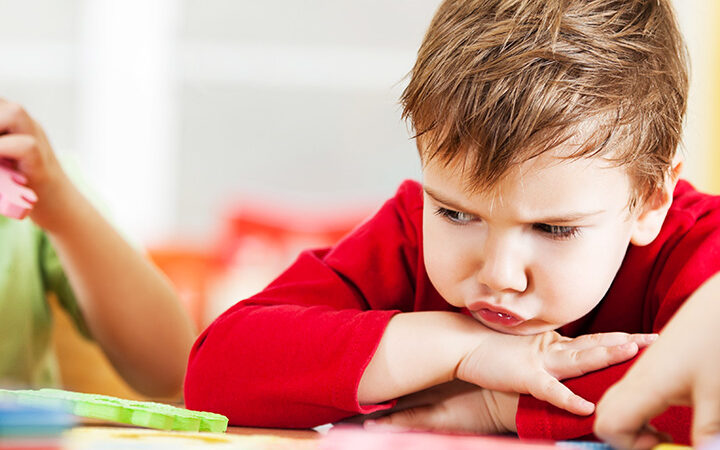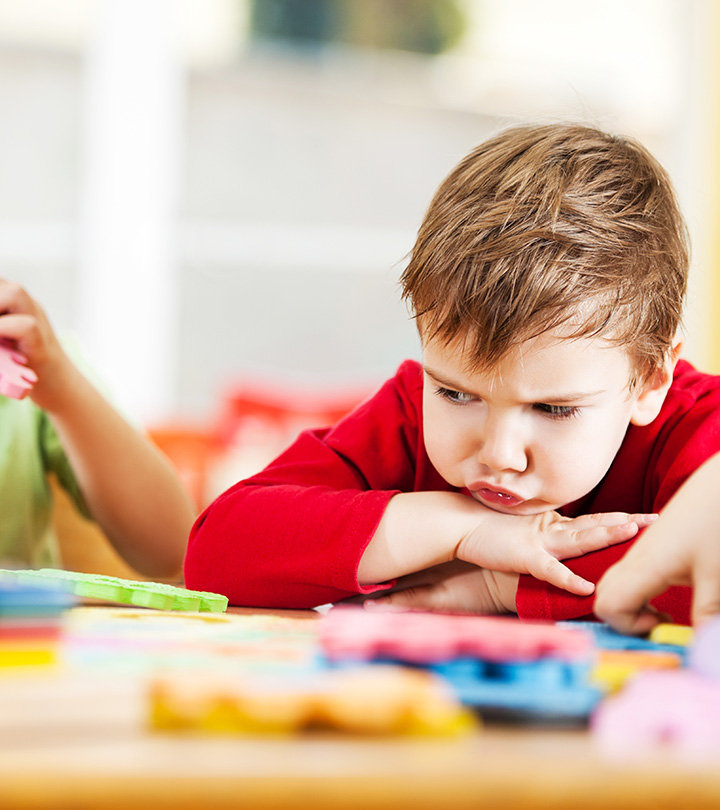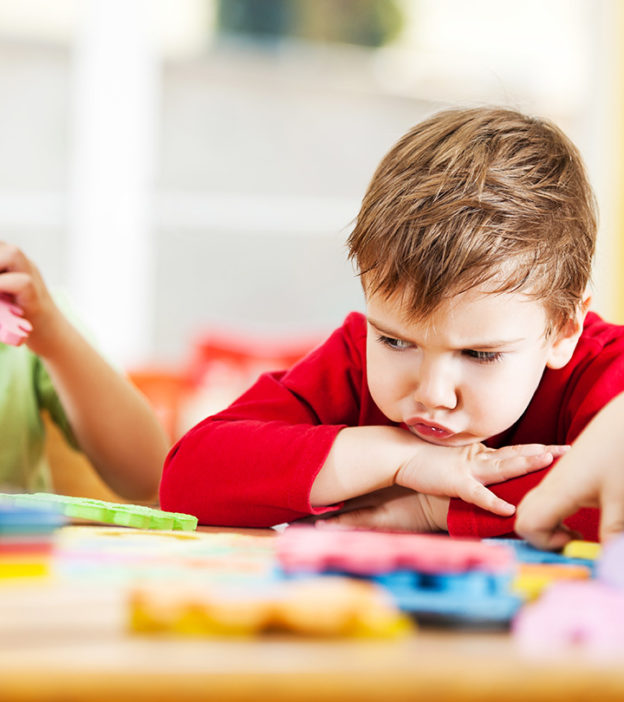Everyone experiences anger, and it is a normal, powerful emotion. Since children cannot understand or express it quite well, they may have anger outbursts or meltdowns. However, anger management activities for kids can help them deal with their anger differently, more healthily, and productively.
Understand that anger is a form of communication, which often arises when a child’s needs are not met, or someone hurts them. Therefore, it is a misconception that anger is destructive and should be avoided or vent out on others. Hiding or venting out anger in incorrect ways may become destructive to self and others (1). Learning to manage anger can create self-awareness, confidence, and peace of mind (2). The following post gives you some anger management activities for children to help you discipline them in the right way.
15 Anger Management Activities For Kids
- Practice deep breathing: Teaching deep breathing to your children can help them control their anger. Breathing slowly and deeply would calm the nervous system (3). They should understand that when someone gets angry, their heartbeat increases, but as they breathe deeply, it slows down. Ask them to place their hands on their heart and feel the beat. You may also introduce breathing games, such as (4):
- Hot chocolate breathing, where they can imagine holding a cup of hot chocolate in their hands. They breathe deeply to take the aroma and then blow out to cool it down for drinking. Children can do a count of five and regularly for practice.
- Teddy bear breathing, where you can place a teddy bear on their belly and give it a fun ride through the rise and fall of their breath. Children can practice this when they are lying down to sleep.
- Blowing birthday candles breathing, where children are supposed to take a deep breath, bring up a happy thought, and pretend to exhale and blow their birthday candles.
- Ocean breathing involves closing your eyes along with your child’s and imagining anger as a fire on a shore. They imagine the ocean waves coming closer and extinguishing the fire as they breathe through their diaphragm.
- Encourage roleplay: Role playing helps children express their emotions better. As they play a character in the roleplay, they learn from how the character dealt with a difficult situation. For example, when upset or angry, let them play a turtle. Allow them to pretend to go inside the shell by covering their heads with arms and staying there until they calm down. This practice will allow children to calm themselves till their anger subsides (4). If you involve children in roleplays regularly, they will become more imaginative and communicative and understand how to talk about their emotions through words (5).
- Create a calm corner: Calm corners are specified places at home or school that children may use to calm themselves when they get angry or upset. These corners focus on bringing mindfulness and peace to children. You can place a soft rug, blankets, favorite books, and soft toys in these corners. Also, add children’s artwork, family photos, and thoughtful quotes for inspiration, if any. Let your children sit here and reflect on the situation before responding. Do not treat calm down corners as time-out zones because children should not associate them with punishment. Instead, be positive and encourage them to spend time in those corners when they are distressed (6).
- Draw a picture: Some children may not be able to express themselves through words but can draw out their emotions. Drawing helps them to calm down and relax. If your children love to draw, encourage them to use it as an activity to manage their anger.
- Identify triggers and avoid them: Many children become angry or upset when asked to do something they do not like or stop doing something they like. For example, they may get angry if you ask them to switch off the television, stop playing, or do their homework. You may identify these triggers and avoid a meltdown by providing time warnings, preparing them for the situation, or breaking the process into steps. So, if you want children to switch off the television, you may tell them that they only have ten more minutes to watch their show. Time warnings will help prepare and avoid sudden outbursts of anger (7).
- Give calmness rewards: When children practice anger management skills and start getting better at them, you should recognize their efforts and reward them. Every time they make an effort to manage their anger, give them a point. You can convert these points into rewards–could be an extra screen time, a toy, or a trip to the park (1). Anger management is challenging for people of all ages, so your children deserve the credit if they use the tools to release anger positively.
- Use an anger journal: Writing down angry thoughts and emotions may help children clear their minds. It also helps them understand a situation better, reflect on what has happened, and look at the scenario differently. You may find that children are calmer and more controlled after penning down their feelings (2).
- Build a feelings vocabulary: Although fluent in talking, many children cannot express their angry emotions. They do not have the proper vocabulary to express their feelings. Therefore, it is essential to introduce emotional vocabulary, including furious, angry, irritated, frustrated, and nervous. Once they learn these words, they can express their anger rather than hiding it or venting it out in an inappropriate way.
- Introduce 1+3+10 activity: Teach children the formula for staying calm whenever they feel angry. Step one is stopping and reminding themselves to stay calm. Then, they should take three slow and deep breaths. After that, they should count to ten. Doing the 1+3+10 activity at a stretch will help them become calm and control their anger
- Try relaxation techniques: Relaxation techniques can help children calm down more quickly when they experience anger. Teach your child to:
- Take a few deep breaths.
- Start relaxing the muscle groups one by one–from the forehead to the jaws, neck, etc. Relax the entire body.
- Get into a calming or relaxing imagination (8).
- Include distracting activities: Distraction is a good way to take children’s attention off the anger. For younger children, try blowing bubbles. Initially, you can use soap solution and a wand to blow real bubbles. As children understand the concept, they can even pretend to blow bubbles as a calming technique. For older children, taking a walk outdoors, listening to music, cycling, etc., may help them distract themselves from anger (8).
- Play emotion charades: Playing this game with family members may help children differentiate between different emotions. Have fun acting out different emotions and actions, and let your child guess. Show them examples of healthy and unhealthy ways of releasing anger and help your children decide which one is an appropriate action.
- Use puppets and stories: Anger could be a negative emotion, and experiencing it may not be correct. However, no emotion is wrong because each one has its purpose. If your child is uncomfortable talking about their anger, use puppets to help them express it. You may also give an exciting name to their anger, like the ‘anger monster’. This will help children get comfortable with the concept of anger and express their feelings better. Stories can also give children insights into how to tackle difficult situations. Reading about characters can inspire children to learn from them and follow their strategies.
- Create an anger iceberg: This activity may work for older children who know about different emotions but cannot express them appropriately. For example, if children are worried, hurt, disappointed, or embarrassed, they find it easier to hide these vulnerable emotions behind anger. However, the only way to calm down is to find out the real reason behind the anger. You may help children draw an iceberg where anger can be at the top, and children may reflect and write the real reasons for their anger at the bottom of the iceberg. This activity will help you and your children understand the reason behind the anger and work towards managing it.
- Personify the anger: Most children who become angry or throw tantrums regularly get to hear that they are a problem. However, this feeling can create adverse effects on them. Talk to your children and tell them that they are not the problem, but their anger is the problem. Help them see their anger as a different personality by giving it a name. Encourage them to imagine and draw a picture of their anger. When children start believing that their anger is a different entity and not a part of them, they feel empowered. This empowerment gives them the freedom to manage their anger in better ways.
Anger is an emotion many children are not adept at expressing because they don’t have the right tools and vocabulary. In the absence of the correct expression techniques, most children demonstrate anger through meltdowns, outbursts, and other aggressive behavior. But hiding anger or taking it out on others may lead to more significant problems. Therefore, as parents, you should teach practical anger management activities to kids from a young age.
Support children and let them know that anger is a normal emotion that indicates an unfulfilled need. Understanding it and working on it will help children stay calm. You may introduce feelings vocabulary, involve them in roleplay, or create a quiet corner for effective anger release.
Key Pointers
- Different anger management activities make children aware of their emotions and ways to handle them.
- Teaching deep breathing to children is an effective way to help them manage their anger.
- Introducing them to anger journals, anger icebergs, and relaxation techniques are good ways to help them release anger.
References:
MomJunction’s articles are written after analyzing the research works of expert authors and institutions. Our references consist of resources established by authorities in their respective fields. You can learn more about the authenticity of the information we present in our editorial policy.
The following two tabs change content below.





































